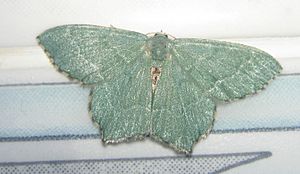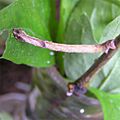Common emerald facts for kids
Quick facts for kids Common emerald |
|
|---|---|
 |
|
| Scientific classification |
The common emerald (Hemithea aestivaria) is a beautiful green moth. It belongs to a group of moths called Geometridae. You can find this moth in many parts of the world. It lives across North America, Europe, Asia, and the Near East. In the British Isles, it's most common in the southern areas. This moth also arrived in southern British Columbia, Canada, by accident in 1979.
Contents
What Does the Common Emerald Look Like?
This moth has lovely dark green wings. The edges of its wings have a cool grey and white checkered pattern. You'll also see thin white lines, called fascia, across its wings. There are two lines on its front wings and one on its back wings.
Unlike some other green moths, the common emerald's green color stays bright. It doesn't fade much over time. Its back wings have a sharp, angled corner. This gives the moth a very special shape. The distance from one wingtip to the other, called its wingspan, is about 30 to 35 millimeters. That's about the size of a large paperclip!
When Does it Fly?
The common emerald moth flies during the evening and night. You can usually spot it in June and July. If you have a light on outside, it might even come to visit!
Life as a Larva (Caterpillar)
The baby common emerald is called a larva, or caterpillar. It is green with reddish-brown marks. It also has black V-shaped marks along its back. When it's very young, the larva eats many different plants. But as it grows, it prefers to munch on trees and shrubs.
This moth spends the winter as a larva. It will hide away until spring. Then it will continue to grow and eventually turn into a moth.
What Do Common Emerald Larvae Eat?
Common emerald caterpillars like to eat leaves from many different plants. Here are some of their favorite food plants:
- Aralia
- Artemisia
- Betula – birch
- Camellia
- Carpinus – hornbeam
- Castanea – chestnut
- Citrus
- Corylus – hazel
- Crataegus - hawthorn
- Diervilla – bush honeysuckle
- Hypericum – St John's wort
- Juglans – walnut
- Larix – larch
- Ligustrum – privet
- Malus – apple
- Morus – mulberry
- Photinia
- Prunus
- Quercus – oak
- Rhamnus – buckthorn
- Ribes – currant
- Rosa – rose
- Rubus
- Salix – willow
- Sorbus – rowan
- Tilia – lime
- Vaccinium
- Viburnum
Images for kids





